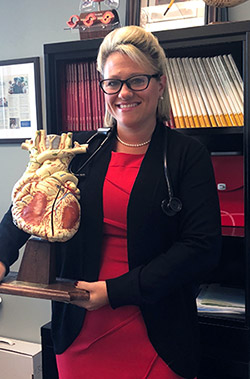Heart disease is the leading cause of death in the United States, and it’s preventable. While symptoms of heart disease often don’t begin to appear until our 50s and 60s, plaque buildup in the arteries begins in our 20s and 30s.
High cholesterol and high blood pressure contribute to the development of heart diseases, such as coronary artery disease, which is caused by fatty deposits inside the heart arteries, and heart failure, which is a weakened heart muscle that can’t pump enough blood for the organs to function properly.
Symptoms of heart disease can include:
- Angina, or mild, passing pain in the chest
- Dizziness
- Fainting
- Fatigue
- Rapid heartbeat
- Shortness of breath
- Swollen legs
If you haven’t noticed symptoms, a preventive cardiologist can help assess your risk and find strategies to reduce it. Once you notice symptoms, we can help improve them. You’re never too young—or too old—to start taking better care of your heart with these four basic strategies.
1. Eat heart-healthy foods
When I meet a new patient, I always focus on nutrition first. It really is the best preventive medicine because dietary changes can help reduce risk factors dramatically. Many patients can reduce their need for medications. These positive effects also are true for diabetes and other systemic illnesses.
A healthy diet is a lifestyle change for the long haul, not a temporary weight-loss gimmick. Once you embrace the change and start to see and feel the benefits, sticking to it becomes easier. After making changes and feeling better, patients will tell me, “I went out last night and had an extra piece of pizza, and I felt so sick afterward. I can’t imagine why I ever used to eat that way all the time!”
Some basic tips about heart-healthy nutrition:
- Avoid foods with high levels of saturated fats, such as beef
- Eat lean protein, such as chicken or fish, in moderation
- Eat mostly fruits and vegetables
- Eat some healthy fats, such as olive oil and avocados
- Eat small portions
2. Know your numbers
Three particular areas relating to diet and weight that I focus on with my patients are their body shapes, their body mass index and their sodium intake.
Don’t be an apple
Waist size can be a screening tool to estimate our cardiac disease risk, because abdominal fat is linked to increased risk of heart disease.
To measure your waist, stand and place a tape measure around your middle, just above your hip bones. Breathe out, and then measure the circumference. For women, risk goes up with a waist size that is more than 35 inches. For men, the risk is greater with a waist circumference of 40 or more. Your goal should be to make sure your waistline is less than those numbers.
Body mass index (BMI)
Everyone should know their BMI, or body mass index. This number is an estimate of body fat. The National Heart, Lung, and Blood Institute’s free BMI calculator can help you find your current BMI. You also can download their free BMI calculator apps for iPhones and Android smartphones.
The higher your BMI, the higher your cardiac risk. Unless we’re very careful about keeping these numbers in check, we can be doing damage to our arteries and hearts for years without knowing it.e
Sodium and blood pressure
Excess sodium in the diet raises blood pressure, which can lead to heart disease. Hypertension is called a silent killer because it does not cause symptoms. Patients often don’t notice the consequences of uncontrolled high blood pressure until it has already caused negative cardiac affects. Patients should routinely measure their blood pressure at home and make sure they are at goal, less than 120/80 mm Hg. Keeping your sodium intake down is a great way to keep your blood pressure at a healthy level. The goal for sodium intake is 1500 – 2000 mg daily.
Related reading: What do the new blood pressure guidelines mean?
3. Get heart-healthy exercise
Get at least 30 minutes of exercise a day, five days a week. It’s never too late to start! For example, I had a patient in his early 70s who had been living a fairly healthy lifestyle until about five years prior, when he started to get some arthritis in his joints. Because of the pain, he exercised less and slowly gained about 50 pounds. His blood pressure and cholesterol went up, and he started to develop occasional chest discomfort.
We did some tests and found mild coronary artery disease. The first thing I recommended was a heart-healthy lifestyle:
- Less animal protein, especially red meat
- Increased fruit and vegetable consumption
- Reduced processed foods and refined sugars
Because of his arthritis, he couldn’t do high-impact exercises like running. We helped him find an aquatics program that allowed him to exercise in a pool, which was much more tolerable on his joints.
Over about six months, he lost nearly all of the weight he’d gained. His systolic blood pressure went from 150 down to 110, and he avoided having to start taking cholesterol medicine. His chest pain improved as well. His quality of life is much improved!
4. Control risk factors for heart disease

Jennifer Brown, MD - Cardiologist
Preventive cardiology with a focus on healthy foods, regular exercise and a generally healthy lifestyle will benefit young and old alike. However, it may not be enough on its own for people who smoke, have a family history of heart disease or have certain uncontrolled conditions.
Family history
If you have a parent, sibling or child with high blood pressure, high cholesterol, coronary artery disease or heart failure, particularly at a young age, you may be genetically more likely to develop these conditions. It’s important to recognize this risk factor and seek preventive cardiology for further optimization of risk factors.
Smoking
Smoking damages the heart and arteries, limiting the flow of oxygen-rich blood to your body and organs. Any amount of smoking, even occasionally, damages the heart and blood vessels. If you smoke, I definitely recommend quitting. If you need help to quit smoking, request an appointment now.
Uncontrolled conditions
We all need to get yearly checkups with a doctor who does lab work and checks our vital signs. If your blood pressure or cholesterol is creeping up over time, you may be able to correct it with dietary changes, exercising more and watching sodium intake before the need for medicines or other treatments.
There are highly effective, inexpensive treatments to manage chronic conditions, and knowing your numbers is very important to keep them in check. It’s also a good idea to ask for a copy of your records, so you can know your numbers.
I have seen many patients absolutely change their path by making lifestyle adjustments. They’re able to come off medications, start exercising more and achieve a healthier lifestyle and a better quality of life. It is never too late to take care of your heart!

